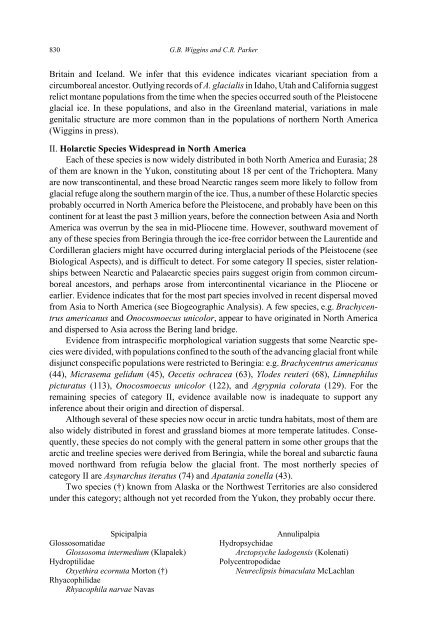Caddisflies of the Yukon - Department of Biological Sciences ...
Caddisflies of the Yukon - Department of Biological Sciences ...
Caddisflies of the Yukon - Department of Biological Sciences ...
Create successful ePaper yourself
Turn your PDF publications into a flip-book with our unique Google optimized e-Paper software.
830 G.B. Wiggins and C.R. Parker<br />
Britain and Iceland. We infer that this evidence indicates vicariant speciation from a<br />
circumboreal ancestor. Outlying records <strong>of</strong> A. glacialis in Idaho, Utah and California suggest<br />
relict montane populations from <strong>the</strong> time when <strong>the</strong> species occurred south <strong>of</strong> <strong>the</strong> Pleistocene<br />
glacial ice. In <strong>the</strong>se populations, and also in <strong>the</strong> Greenland material, variations in male<br />
genitalic structure are more common than in <strong>the</strong> populations <strong>of</strong> nor<strong>the</strong>rn North America<br />
(Wiggins in press).<br />
II. Holarctic Species Widespread in North America<br />
Each <strong>of</strong> <strong>the</strong>se species is now widely distributed in both North America and Eurasia; 28<br />
<strong>of</strong> <strong>the</strong>m are known in <strong>the</strong> <strong>Yukon</strong>, constituting about 18 per cent <strong>of</strong> <strong>the</strong> Trichoptera. Many<br />
are now transcontinental, and <strong>the</strong>se broad Nearctic ranges seem more likely to follow from<br />
glacial refuge along <strong>the</strong> sou<strong>the</strong>rn margin <strong>of</strong> <strong>the</strong> ice. Thus, a number <strong>of</strong> <strong>the</strong>se Holarctic species<br />
probably occurred in North America before <strong>the</strong> Pleistocene, and probably have been on this<br />
continent for at least <strong>the</strong> past 3 million years, before <strong>the</strong> connection between Asia and North<br />
America was overrun by <strong>the</strong> sea in mid-Pliocene time. However, southward movement <strong>of</strong><br />
any <strong>of</strong> <strong>the</strong>se species from Beringia through <strong>the</strong> ice-free corridor between <strong>the</strong> Laurentide and<br />
Cordilleran glaciers might have occurred during interglacial periods <strong>of</strong> <strong>the</strong> Pleistocene (see<br />
<strong>Biological</strong> Aspects), and is difficult to detect. For some category II species, sister relationships<br />
between Nearctic and Palaearctic species pairs suggest origin from common circumboreal<br />
ancestors, and perhaps arose from intercontinental vicariance in <strong>the</strong> Pliocene or<br />
earlier. Evidence indicates that for <strong>the</strong> most part species involved in recent dispersal moved<br />
from Asia to North America (see Biogeographic Analysis). A few species, e.g. Brachycentrus<br />
americanus and Onocosmoecus unicolor, appear to have originated in North America<br />
and dispersed to Asia across <strong>the</strong> Bering land bridge.<br />
Evidence from intraspecific morphological variation suggests that some Nearctic species<br />
were divided, with populations confined to <strong>the</strong> south <strong>of</strong> <strong>the</strong> advancing glacial front while<br />
disjunct conspecific populations were restricted to Beringia: e.g. Brachycentrus americanus<br />
(44), Micrasema gelidum (45), Oecetis ochracea (63), Ylodes reuteri (68), Limnephilus<br />
picturatus (113), Onocosmoecus unicolor (122), and Agrypnia colorata (129). For <strong>the</strong><br />
remaining species <strong>of</strong> category II, evidence available now is inadequate to support any<br />
inference about <strong>the</strong>ir origin and direction <strong>of</strong> dispersal.<br />
Although several <strong>of</strong> <strong>the</strong>se species now occur in arctic tundra habitats, most <strong>of</strong> <strong>the</strong>m are<br />
also widely distributed in forest and grassland biomes at more temperate latitudes. Consequently,<br />
<strong>the</strong>se species do not comply with <strong>the</strong> general pattern in some o<strong>the</strong>r groups that <strong>the</strong><br />
arctic and treeline species were derived from Beringia, while <strong>the</strong> boreal and subarctic fauna<br />
moved northward from refugia below <strong>the</strong> glacial front. The most nor<strong>the</strong>rly species <strong>of</strong><br />
category II are Asynarchus iteratus (74) and Apatania zonella (43).<br />
Two species (†) known from Alaska or <strong>the</strong> Northwest Territories are also considered<br />
under this category; although not yet recorded from <strong>the</strong> <strong>Yukon</strong>, <strong>the</strong>y probably occur <strong>the</strong>re.<br />
Spicipalpia<br />
Glossosomatidae<br />
Glossosoma intermedium (Klapalek)<br />
Hydroptilidae<br />
Oxyethira ecornuta Morton (†)<br />
Rhyacophilidae<br />
Rhyacophila narvae Navas<br />
Annulipalpia<br />
Hydropsychidae<br />
Arctopsyche ladogensis (Kolenati)<br />
Polycentropodidae<br />
Neureclipsis bimaculata McLachlan
















